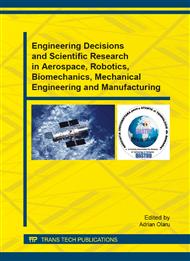[1]
International Launch Services Press Release, Tuesday, Sep. 6, (2005).
Google Scholar
[2]
SpaceX Excellent Engineers Wanted, Aviation Week and Space Technology, Sep. 25, 2006, p.67.
Google Scholar
[3]
M. Sarigul-Klijn, N. Sarigul-Klijn, B. Morgan, J. Tighe, A. Leon, G. Hudson, B. McKinney & D. Gump, Flight Testing of a New Air Launch Method for Safely Launching Personnel and Cargo into LEO, Paper AIAA-2006-1040.
DOI: 10.2514/6.2006-1040
Google Scholar
[4]
http: /www. nasa. gov/home/hqnews/2007/feb/HQ_0720_COTS_agreements. html, ** NASA Signes Agreement with t/Space, 02. 01. (2008).
Google Scholar
[5]
Makeyev Offers Site, Aviation Week and Space Technology, 26 April 1993, p.65.
Google Scholar
[6]
H. H. Koelle, Handbook of Astronautical Engineering, McGraw-Hill, N.Y., (1961).
Google Scholar
[7]
Lindberg, Robert E., Overview of the Pegasus Air-Launched Space Booster, SAE, Aerospace Technology Conference and Exhibition, Anaheim, CA, Sept. 25-28, (1989).
DOI: 10.4271/892308
Google Scholar
[8]
H. Matsuo, W. Kohno, T. Makino, Y. Nagao, H. Hirose, Conceptual study of air-launch small satellite launcher system, 35th Space Sci. and Tech. Conf., Nagaoka, Japan, Oct. 28-31, (1991).
Google Scholar
[9]
M. Sarigul-Klijn, and N. Sarigul-Klijn, A Study of Air Launch Methods for RLVs, AIAA Paper 2001-4619.
DOI: 10.2514/6.2001-4619
Google Scholar
[10]
M. Sarigul-Klijn, N. Sarigul-Klijn, G. C. Hudson L. Holder, G. Liesman, D. Shell, and Ch. Webber, Gravity Air Launching of Earth-To-Orbit Space Vehicles, Paper AIAA 2006-7256.
DOI: 10.2514/6.2006-7256
Google Scholar
[11]
H. O. Ruppe, Der Zukunft im All, manuscript from the author, (2001).
Google Scholar
[12]
R. D. Rugescu, NERVA Romanian Non-Orbital Entry-Return Vehicle Assessor Project, Texas A&M University, USA, Paper IAC-06-B5. 5. 11, Proc. 57th IAC, Valencia, Spain, Oct. 02-06, (2006).
DOI: 10.2514/6.iac-06-b5.5.11
Google Scholar
[13]
R. D. Rugescu, J. Kohlenberg, Mahendiran Prathaban, Space Imaging Infrastructure Development of PUBSAT and NERVA Orbital Vehicle, Proceedings of the Third International Conference on Systems and Networks in Communications ICSNC-2008, ISBN: 978-0-7695-3371-1, Digital Object Identifier: 10. 1109/ICSNC. 2008. 53, Sliema, Malta, October 26-31, 2008, pp.298-303.
DOI: 10.1109/icsnc.2008.53
Google Scholar
[14]
Stoica, A.M., Berbente, S., Stroe, G., Barbelian, M.A., Design handbook for Automatic Command of aircraft, UPB Press, Bucharest, (2006).
Google Scholar


